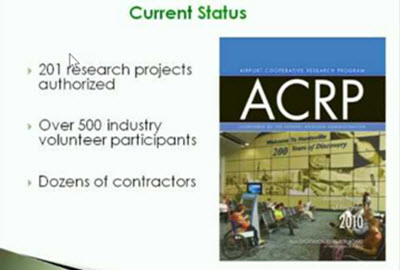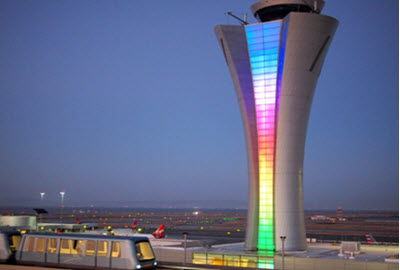New report says improved wayfinding makes airports more accessible
- Written by Roberto Castiglioni
 The Airport Cooperative Research Program (ACRP) is to publish a study featuring a first-of-its-kind tool for airports, the Wayfinding Accessibility Audit Checklist.
The Airport Cooperative Research Program (ACRP) is to publish a study featuring a first-of-its-kind tool for airports, the Wayfinding Accessibility Audit Checklist.
Managed by the Transportation Research Board of the National Academies of Sciences, Engineering, and Medicine, and sponsored by the Federal Aviation Administration, the Airport Cooperative Research Program (ACRP) is an industry-driven research program that develops solutions to problems faced by airport operators.
Laurel Van Horn from Open Doors Organization shares more on this innovative tool ahead of her presentation on the subject on March 16th at Passenger Terminal Conference 2017 in Amsterdam.
I asked Laurel, a well-known expert in the field of access to air travel if she thinks the air travel industry is heading in the right direction in the field of facilitation.
"I do think the air travel industry has made major strides in improving facilitation for travelers with disabilities, but  challenges obviously still remain, in large part due to the fast growing demand for assistance by older travelers.
challenges obviously still remain, in large part due to the fast growing demand for assistance by older travelers.
Within the past few months, I have had managers from three major U.S. airports tell me that their goal is to become the world's most accessible airport. The discussion is moving beyond compliance with minimum accessibility standards to a focus instead on customer experience.
This is even more remarkable since in the U.S. it's the airlines that are mainly responsible for assisting passengers with disabilities, not the airports. But airports are now realizing that poor customer service, whether by airlines, vendors or ground transport providers, also reflects on them.
At Open Doors Organization we see a definite trend toward more communication and problem solving among aviation stakeholders, often involving representatives from the disability community as well."
Airports Cooperative Research Program will soon publish a study on enhancing wayfinding for ageing population and PRMs. I asked Laurel what stands out in the ACRP's latest report.
"The new ACRP report, due for publication shortly, is really about enabling independent travel, both by successfully communicating wayfinding information (by visual, verbal, virtual and tactile means) and by addressing other issues that limit independence regardless of wayfinding abilities, e.g., walking distances, lack of seating, etc.
 At the heart of the report is a first-of-its-kind tool for airports, the Wayfinding Accessibility Audit Checklist, that merges wayfinding analyses and accessibility audits into a single, all-inclusive assessment. Many of its recommendations are illustrated in Virtual 3D Models. The checklist will be available from the ACRP in a separate electronic format, making it readily useable by the industry.
At the heart of the report is a first-of-its-kind tool for airports, the Wayfinding Accessibility Audit Checklist, that merges wayfinding analyses and accessibility audits into a single, all-inclusive assessment. Many of its recommendations are illustrated in Virtual 3D Models. The checklist will be available from the ACRP in a separate electronic format, making it readily useable by the industry.
Also noteworthy is the report's final chapter on the application and implementation of accessible wayfinding technologies such as digital directories, information kiosks, and mobile apps. Included are 19 research-based criteria for creating a universally accessible wayfinding app with lists of Do's and Don'ts for developers to follow. Hopefully, this new guidance will help airports improve existing apps or create new ones that meet the needs of travelers with disabilities. To date, no single mobile application has been developed that provides essential route information useful to all users but the potential is certainly there."
Ideas can be great, but sometimes putting them into practice may not be completely straightforward. I asked Laurel to give me some best practice examples.
"In the ACRP report, we share numerous best practice examples from the US and worldwide, everything from the intuitive design of the buildings themselves to effective design and illumination of signage.
Even contrasting colors and textures of floors and carpets can enhance wayfinding. Some airports are making great use of their websites to post captioned wayfinding videos, for example, Cincinnati Northern Kentucky (CVG) which also provides the captions as separate text descriptions for travelers with vision loss or cognitive disabilities.
Airports that show distances or walking times to gates on their websites or digital directories enable travelers to decide for  themselves if they can walk, should take a tram or will need to request an electric cart or wheelchair. The quality of verbal information is also important.
themselves if they can walk, should take a tram or will need to request an electric cart or wheelchair. The quality of verbal information is also important.
Disability awareness and communication training paired with knowledge of the airport and its accessibility features is essential for staff at call centers and information desks. When armed with digital tablets, they can also provide Video Relay Interpreting for customers who are deaf or translations for foreign visitors, as at Minneapolis-St Paul and San Francisco International Airports."
Disability advocates and access to air travel experts focus on passengers with disabilities, but truth be told facilitation has a much wider catchment area. I asked Laurel if this isn't reason good enough for the air travel industry to take action on accessibility sooner.
"The ACRP report's recommendations, both for design of the built environment and information and wayfinding technologies, are based on the principles of universal design.
As airports become larger and more complex, all travelers benefit from intuitive design and presentation of information in multiple formats. Pictograms, for example, serve not just individuals with intellectual disabilities but also international travelers unfamiliar with the local language. In a noisy environment, presenting boarding information visually on GIDS as well via the PA system ensures that everyone in the gate area gets the message.
A focus on inclusion and universal access needs to inform every planning decision and investment in IT and should be considered a key component of sustainability."
Laurel Van Horn is scheduled to speak on March 16th in the Ageing Population and PRMs track at PTE2017.










